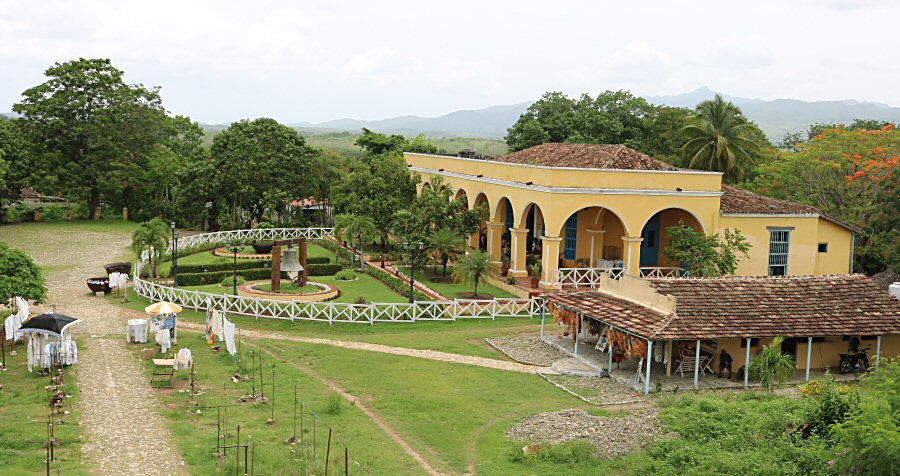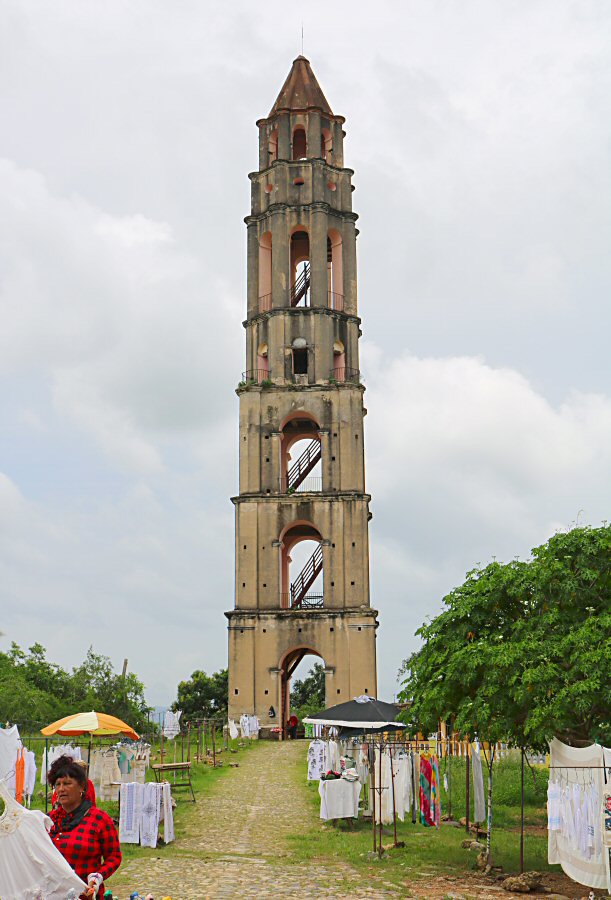INGENIO MANACA-IZNAGA
The valley’s prestigious past can be
partly appreciated at the hacienda of Manaca-Iznaga, one of the old colonial
estates.
Deriving its name from the indigenous
term for the property, 'manacanacu or manacú', and the surname
'Iznaga' of the prominent landowner family Iznaga, the history
of Manaca-Iznaga is one of great historical and cultural
significance.
Irrigated mainly by the Río de Ay,
the Manaca-Iznaga sugar mill occupied an area of land
measuring 90 caballerias (appr. 12 km2). In Spain and countries
settled by the Spanish, caballerias is a land measure of varying size. In Cuba
it is about 33 acres; in Puerto Rico, about 194 acres; in the
Southwestern United States, about 108 acres.
History
The earliest record of the Manaca-Iznaga sugar mill is
Manuel José de Tellería's licence application to the town
council to build a sugar mill on the Corral Manacú estate in
1750. Corral means generally uncovered enclosure, next to the
rural houses, which is used to keep domestic livestock.
According to the native people, this farm was previously
purchased by José de Tellería from Franco de Aguilar for 400
pesetas. The land was located 12 km from Trinidad on the north
of the road connecting Trinidad to Sancti Spirutus. The
extensive land of the hacienda adjoined the sugar mills San José
de la Cruz, Buena-Vista, Manaca Armenteros, Corojal and Las
Hocas. Initially, the sugar mill was called Manaca de Telleria.
The assets of Manuel José de Tellería, who was in an
economically difficult situation, was sold to Thomas Joseph
Muñoz at auction in 1776 for 1726 pennies and 5,5 reales. Thus,
ownership of the Manaca-Iznaga sugar mill passed to Thomas
Joseph Muñoz.
After the death of Thomas Joseph Muñoz in 1787, the sugar mill
was inherited by his son Fernando Muñoz. Fernando Muñoz named
the sugar mill San Francisco Javier.
In 1795, Joaquina Josefa Muñoz y Herrera, daughter of the couple
Fernando Muñoz and Simona Herrera, sold the sugar mill to Pedro
José Iznaga y Pérez de Vargas Sotomayor for 24.000 pesos. When
Pedro José Iznaga bought the sugar mill, only 28 slaves were
working there. Pedro José Iznaga y Pérez de Vargas Sotomayor, a
Trinitarian descendant of Biscayans (a native or resident of
Biscay province, Spain), IX. Lord of the Casa Solar Infanzona de
Iznaga. He added wealth and power to his wealth by marrying
Maria Del Carmen Borrell y Padron. He is a person that became
one of the Cuba's wealthiest men through slave trafficking.
Upon the death of Pedro José Iznaga in 1814, his widow Maria del
Carmen Borrell inherited 80.913 pesos and two sugar mills. One
of these sugar mills was today's Manaca-Iznaga sugar mill, which
was called Alejo de Manacas when Pedro José Iznaga was alive,
but it was called San Francisco Javier when that sugar mill
belonged to the Muñoz family. While Pedro Iznaga was alive, the
sugar mill was run by his son Alejo. After his father's death,
his mother wanted Alejo to continue running the sugar mill until
her death in 1831.
Alejo succeeded in the the establishment of a sugar mill with
modern equipment and made certain improvements in sugar
production. In 1841, the sugar mill had a very good harvest so
that it produced 5.600 boxes of sugar. In 1846 the jurisdiction
reached the highest figure for sugar production in its history.
Between the 1820s and 1840s, this was one of the sugar mills
with the best harvests and profits in the Cuban sugar industry.
In 1826 Alejo Iznaga y Borrell married Juana Nepomuceno
Hernández, who died in 1860 and left the a third of her assets
to her sons Alejo and Teodoro Iznaga y Hernandez de Rivera.
Consequently, in 1862, the Manacas sugar mill with 231 slaves,
valued at 428.185 pesos, along with other less important
properties, passed into the hands of Teodoro Iznaga y Hernández
who named the sugar mill Manacas sugar mill. When Teodoro Iznaga
y Hernández died, he was succeeded by his sister Maria del
Carmen Iznaga y Hernandez de Rivera. Maria del Carmen, along
with others who shared the inheritance, managed the Manacas
sugar mill, which reached a value of about 500.000 pesos in
1881.
However, Trinidad began a long process of decline starting in
the mid-nineteenth century.

